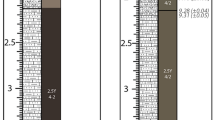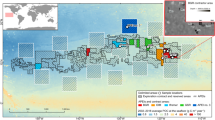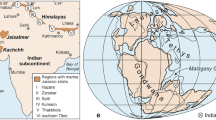Summary
The Silurian of Gotland is characterized by repeated changes in depositional facies development. The deposition of uniform sequences of micritic limestones and marls was interrupted four times by the growth of reef complexes and the formation of expanded carbonate platforms. Coinciding with these, often abrupt, facies changes extinction events occurred which predominantly affected nektonic and planktonic organisms. Ratios of carbon- and oxygen-isotopes covary with the facies development. Periods in which the deposition of limestonemarl alternations prevailed are characterized by relatively low C- and O-isotope values. During periods of enhanced reef growth isotope values are high. For these changes,Bickert et al. (1997) assume climatic changes between humid “H-periods”, with estuarine circulation systems and cutrophic surface waters with decreased salinity in marginal seas, and arid “A-periods”, with an antiestuarine circulation and oligotrophic, stronger saline surface waters.
In order to separate local and regional influences on the isotopic development from the global trend, the interactions between facies formation and isotope record have to be clarified. For this purpose, the patterns of isotope values in the upper part of the Silurian sequence on Gotland (upper Wenlock —upper Ludlow) has been determined and stratigraphically correlated along four transects through different facies areas. Facies formation during this time interval was investigated by differentiation and mapping of twelve facies complexes in the southern part of Gotland. These include shelf areas, reef complexes with patch reefs and biostromes, backreef facies, and marginal-marine deposits. The good correspondence between the carbon-isotope records of the four transects suggests that local environmental conditions in the different facies areas did not influence the δ13C values. Therefore, a supra-regional or even global mechanism for the C-isotope variations is likely.
In contrast to carbon istopes, the oxygen-isotope values of the four transects generally show parallel trends, but higher variabilities and in parts distinctly deviating developments with a trend to more negative values. These are interpreted as an effect of local warming in small shallow-water areas which developed during arid periods in reef complexes and backreef areas.
The boundaries between A-periods and H-periods, as defined by δ13C values, which are interpreted as isochrones, can be mapped. From the upper Homerian to the Pridolian six parastratigraphic isotope zones are defined which only partly match the stratigraphic division ofHede (1942, 1960). The isotope stratigraphy results in an improved correlation between the shallow and marginal-marine areas in the eastern part of Gotland and the uniform shelf areas at the west coast of the island.
Furthermore, a detailed relationship between the development of carbon and oxygen isotope ratios, the carbonate facies formation, and the succession of palaeontological events could be observed. At the transition from H-periods to A-periods, major extinction events occurred prior to the first increase of δ13C and δ18O values. Extinction events affected conodonts, graptolites, acritarchs, chitinozoans, and vertebrates and resulted in impoverished nektonic and planktonic communities. The reef-building benthos was less affected. Parallel to a first slight increase of isotope values, facies began to change, and reefs developed in suitable locations. The subsequent rapid increase of C- and O-isotope values occurred contemporarily with strong facies changes and a short-term drop of sea-level. Oligotrophic conditions in the later stages of A-periods led to strong reef growth and to an expansion of carbonate platforms.
The transitions from A-periods to H-periods were more gradual. The δ13C values decreased slowly, but reef growth continued. Later the reefs retreated and were covered by the prograding depositional facies of shelf areas. The diversity of planktonic and nektonic communities increased again.
The close relationship between facies formation, palaeontological events and isotope records in the Silurian suggests common steering mechanisms but gives no indication of the causes for the repeated extincion events related to H-period/A-period transitions. Especially the observation, that strong extinctions occurred prior to changes of isotope values and facies, points to causes that left no signals in the geological record. Hypothetical causes like collapse of trophical nets, anoxias, or cooling events are not evident in the sediment record or do not fit into the regular succession of period transitions.
Similar content being viewed by others
References
Azmy, K., Veizer, J., Bassett, M.G. &Copper, P. (1998): Oxygen and carbon isotopic composition of Silurian brachiopods: Implications for coeval seawater and glaciations.—Geol. Soc. Amer. Bull.,110, 1499–1512
Bassett, M.G., Kaljo, D. &Teller, L. (1989): The Baltic region.— Nat. Mus. Wales, Geol. Ser.,9, 158–170
Bickert, T., Pätzold, J., Samtleben, C. &Munnecke, A. (1997): Paleoenvironmental changes in the Silurian indicated by stable isotopes in brachiopod shells from Gotland, Sweden.— Geochimica et Cosmochimica Acta61, 2717–2730
Bickert, T. &Wefer, G. (1999): South Atlantic and benthic formanifer δ13C - deviations: Implications for reconstructing the Late Quaternary deep-water circulation.—Deep-Sea Res.,46, 137–452
Brenchley, P. J. (1988): Environmental changes close to the Ordivician-Silurian boundary.—In:Cocks, L.R.M. & Rickards R.B. (eds.), A global Analysis of the Ordovician-Silurian Boundary.—Brit. Mus. (Nat. Hist.) Bull,43 (Geol. Ser.), 177–385
Brenchley, P. J., Carden, G.A.F., &Marshall, J.D. (1995): Environmental changes associated with the “first strike” of the late Ordovicium mass extiriction.—Modern Geol.,20, 19–82
Brood, K. (1976): Bryozoan palaeoecology in the Late Silurian of Gotland.—Palaeogeogr., Palaeoclimatol., Palaeoecol.,20, 187–208
Calner, M. (1999a): Stratigraphy, facies development and depositional dynamics of the Late Wenlock Fröjel Formation, Gotland, Sweden.—Geologiska Föreningens Förhandlingar,121, 13–24
— (1999b): Comments to the mid-late Homerian (Silurian) sealevel curve.—Lund Publ. Geol.,144, p. 1
Calner, M. &Jeppsson, L. (1999): Emersion and subaerial exposure in the Silurian of Gotland—response to a mid-Homerian glaciation.—GFF,121, 78–79
Calner, M. &Säll, E. (1999): Transgressive oolites onlapping a Silurian rocky shoreline unconformity, Gotland, Sweden.— Geologiska Föreningens Förhandlingar,121, 91–10
Cherns, L. (1982): Palaeokarst, tidal erosion surfaces and stromatolites in the Silurian Eke Formation of Gotland, Sweden.— Sedimentology,29, 119–833
— (1983): The Hemse-Eke boundary: facies relationships in the Ludlow Series of Gotland, Sweden.—Sveriges Geologiska Undersökning Ser. C,800, 1–45
Corfield, R.M., Siveter, D.J., Cartlidge, J.E. &McKerrow, W.S. (1992): Carbon isotope excursion near the Wenlock-Ludlow (Silurian) boundary in the Anglo-Welsh area.—Geology,20, 371–374
Frykman, P. (1985): Subaerial exposure and cement stratigraphy of a Silurian bioherm in the Klinteberg Beds, Gotland, Sweden.— Geologiska Föreningens. Förhandlingar,107, 17–88
— (1989): Carbonate ramp facies of the Klinteberg Formation, Wenlock—Ludlow transition on Gotland, Sweden.—Sveriges Geologiska Undersökning, C820, 1–79
Harland B., Armstrong, L.L., Cox A.V., Craig, L.E., Smith A.G. &Smith, D.G. (1990): A geologic time scale 1989.—pp. 263, Cambridge (Cambridge University Press)
Hede, J.E. (1921): Gottlands Silurstratigrafi.—Sveriges Geologiska Undersökning, Ser. C,305, 1–100
Hede, J.E. (1925): Berggrunden (Silursystemet).—In:Munthe, H., Hede, J.E. & von Post, L.: Beskrivning till kartbladet Ronehamn.,— Sveriges Geologiska Undersökning, Aa156, 14–51
Hede, J.E. (1927a): Berggrunden (Silursystemet).—In:Munthe, H., Hede, J.E. & Lundquist, G.: Beskrivning till kartbladet Klintehamn.— Sveriges Geologiska Undersökning, Aa160, 12–48
Hede, J.E. (1927b): Berggrunden (Silursystemet).—In:Munthe, H., Hede. J.E. & Lundquist, G.: Beskrivning till kartbladet Hemse.— Sveriges Geologiska Undersökning, Aa164, 15–56
Hede, J.E. (1928): Berggrunden (Silursystemet).—In:Munthe, H., Hedf, J.E. & Lundquist, G.: Beskrivning till kartbladet Slite.—Sveriges Geologiska Undersökning, Aa169, 13–65
Hede, J.E. (1929): Berggrunden (Silursystemet).—In:Munthe, H., Hede, J.E. & Lundquist, G.: Beskrivning till kartbladet Katthammarsvik.— Sveriges Geologiska Undersökning, Aa170: 14–57
— (1942): On the correlation of the Silurian of Gotland.—Meddel. Lunds Geol.-Miner. Inst.,101, 1–25
Hede, J.E. (1960) The Silurian of Gotland. Guide to excursions A22 and C17.-21st Internat. Geol. Congress Copenhagen. pp. 44–89
House, M. R. (1985): Correlation of mid-Palaeozoic ammonoid evolutionary events with global sedimentary perturbations.— Nature,313, 17–22
Jaeger, H. (1991): Neue Standard-Graptolithenzonenfolge nach der “Großen Krise” an der Wenlock/Ludlow-Grenze (Silur).— N. Jb. Geol. Paläont., Abh.,182, 103–354.
Jeppsson, L. (1987): Lithological and conodont distributional evidence for episodes and anomalous oceanic conditions during the Silurian.—In:Aldridge, R.J. (ed.): Palaeobiology of Conodonts. —129–145, Chichester (Ellis Horwood)
— (1990): An oceanie model for lithological and faunal changes tested on the Silurian record.—J. Geol. Soc. London,147, 663–674
— (1993): Silurian events: the theory and the conodonts.—Proc. Estonian Acad. Sci.,42, 13–27
Jeppsson, L. (1994): A new standard Wenlock conodont zonation.—In:Schönlaub, H.P. & Kreutzer, L.H. (eds.): IUGS Subcommision on Silurian Stratigraphy—Field Meeting Eastern & Southern Alps. Austria.—Ber. Geol. Bundes-Anst.,30, p. 133
— (1997): The anatomy of the mid-Early Silurian Ireviken Event and a scenario for P-S Events.—In:Breit, C.E. &Baird, G. (eds.): Paleontological Event Horizons—Ecological and Evolutionary Implications.—451–492, New York Columbia University Press)
Jeppsson, L. (1998): Silurian Oceanic Events: Summary of General Characteristices.— In:Landing, E. & Johnson, M.E. (eds.): Silurian Cycles: Linkages of dynamic stratigraphy with atmospheric, oceanic and tectonic changes.—James Hall Centennial Volume, New York State Mus.Bull.,491, 139–257
Jeppsson, L., Aldridge, R.J. &Dorning, K.J. (1995): Wenlock (Silurian) oceanic episodes and events.—J. Geol. Soc. London,152, 187–498
Jeppsson, L. &Männik, P. (1993): High resolution correlations between Gotland and Estonia near the base of the Wenlock.— Terra Nova,5, 348–358
Jeppsson, L., Vira, V. &Männik, P. (1994): Silurian conodont-based correlations between Gotland (Sweden) and Saaremaa (Estonia). —Geol. Mag.,131/2, 101–218
Johnson, M.E., Cocks, L.R.M. &Copper, P. (1981): Late Ordovician-Early, Silúrian fluctuations in sea level from eastern Anticosti Island, Quebec.—Lethaia,14, 13–82
Johnson, M.E. (1996): Stable cratonic sequences and a standard for Silurian custasy.—In:Witzke, B.J., Ludvigson, G.A. & Day, J. (eds.): Paleozoic sequence stratigraphy: views from the North American craton.—Geol. Soc. Amer., Special Paper,306, 103–211
Johnson, M.E., Kalio, D. &Rong, J.-Y. (1991): Silurian eustasy.— Special Papers Palaeontology,44, 145–163
Kaljo, D., Boucot, A.J., Corfield, R.M., Le Herissé, A., Koren, T.N., Kriz, J., Männik, P., Märss, T., Nestor, V., Shaver, R.H., Siveter, D.J. &Vitra, V. (1995): Silurian Bio-Events.— In:Walliser, O.H. (ed.): Global Events and Event Stratigraphy in the Phanerozoic.—173–223, Berlin (Springer)
Kalio, D., Kipli, T. &Martma, T. (1997): Carbon isotope event markers through the Wenlock-Pridoli sequence at Ohesaare (Estonia) and Priekule (Latvia).—Palaeogeogr., Palaeoclimatol., Palaeoecol.,132, 111–223
Kaljo, D., Kiipli, T. & Martma, T. (1998): Correlation of Carbon Isotope Events and Environmental Cyclicity in the East Baltic Silurian.—In:Landing, E. & Jounson M.E. (eds.): Silurian Cycles: Linkages of Dynamic Stratigraphy with Atmospheric. Oceanic and Tectonic Changes.—James Hall Centennial Volume, New York State Mus. Bull.,491, 197–312
Kano, A. (1989): Deposition and Palaeoecology of an Upper Silurian stromatoporoid reef on southernmost Gotland.—Geol. Jour.,24, 195–315.
Keeling, M. &Kershaw, S. (1994): Rocky shore environments in the Upper Silurian of Gotland, Sweden.—Geologiska Föreningens Förhandlingar.,116, 19–74
Kershaw, S. (1987): Stromatoporoid-coral intergrowths in a Silurian Biostrome.—Lethia.20, 371–380
Kershaw, S. (1993): Sedimentation control on growth of stromatoporoid reefs in the Silurian of Gotland, Sweden.—J. Geol. Soc. London,150, 197–205
Kershaw, S. &Keeling, M. (1994): Factors controlling the growth of stromatoporoid biostromes in the Ludlow of Gotland, Sweden.— Sed. Geol.,89, 125–335
Koren, T.N., Lenz, A.C., Loydell, D.K., Melchin, M.J., Storch, P. &Teller, L. (1996): Generalized graptolite zonal sequence defining Silurian time intervals for global paleogeographic studies.—Lethaia,29, 19–60
Laufeld, S. (1974a): Silurian Chitinozoa from Gotland.—Fossils and Strata,5, 1–130
— (1974b): Reference localities for palaeontology and geology in the Silurian of Gotland.—Sveriges Geologiska Undersökning, C705, 1–172
Laufeld, S. &Bassett, M.G. (1981): Gotland: the anatomy of a Silurian carbonate platform.—Episodes,2, 13–27
Loydell, D.K. (1998): Early Silurian sea-level changes.—Geol. Mag.,135, 147–471
Manten, A.A. (1971): Silurian reefs of Gotland.—Developments in Sedimentology,13, 1–539, Amsterdam (Elsevier)
Martinsson, A. (1965): The Siluro-Devonian Ostracode genusNodibeyrichia and faunally assiciated kloedenines.—Geologiska Föreningens Förhandlingar,87, 109–138
— (1967): The succession and correlation of ostracode faunas in the Silurian of Gotland.—GFF,89, 150–386
McGhee, G.R., Bayer, U. &Seilacher, A. (1991): Biological and evolutionary responses to transgressive-regressive cycles.—In:Einsele, G., Ricken, W. &Seilacher, A. (eds.): Cycles and Events in Stratigraphy.—696–708, Berlin (Springer)
McKerrow, W.S. (1979): Ordovician and Silurian changes in sea level.—J. Geol Soc. London,136, 137–145
Munnecke, A. &Samtleben, C. (1996): The formation of micritic limestones and the development of limestone-marl alternations in the Silurian of Gotland, Sweden.—Facies,34, 159–176
Munnecke, A., Westphal, H., Reijmer, J.J.G. &Samtleben, C. (1997): Microspar development during early marine burial diagenesis: a comparison of Pliocene carbonates from the Bahamas with Silurian limestones from Gotland (Sweden).— Sedimentology,44, 977–990
Munthe, H. (1921): Beskrivning till karbladet Burgsvik jämte Hoburgen och Ytterholmen.—Sveriges Geologiska Undersökning Aa,152, 1–172
Riding, R. (1981): Composition, structure and environmental setting of Silurian bioherms and biostromes in northern Europe.—In:Toomey, D.F. (ed.): European Fossil Reef Models.—Society of Economic Plaeontologists and Mineralogists, Spec. Publ., 30, 11–83
Samtleben, C., Munnecke, A., Bickert, T. &Pätzold, J. (1996): The Silurian of Gotland (Sweden): facies interpretation based on stable isotopes in brachiopod shells.—Geologische Rundschau,85, 178–292
Samtleben, C., Munnecke, A., Bickert, T. & Pätzold, J. (in press): Shell succession, assemblage, and species dependent effects on the C/O-isotopic composition of brachiopods—examples from the Silurian of Gotland.—Chemical Geology
Schönlaub, H.P. (1986): Significant geological events in the Paleozoic record of the Southern Alps (Austrian Part).—In:Walliser, O.H. (ed.): Global Bio-events.—163–167 Berlin (Springer)
Stel, J.H. &de Coo, J.C.M. (1977): The Silurian Upper Burgsvik and Lower Hamra-Sundre Beds, Gotland.—Scripta Geol.,44, 1–43
Sundquist, B. (1982a): Wackestone petrography and bipolar orientation of cephalopods as indicators of littoral sedimentation in the Ludlovian of Gotland.—Geologiska Föreningens Förhandlingar,104, 11–90
— (1982b): Palaeobathymetric interpretation of wave ripple-marks in a Ludlovian grainstone of Gotland.—Geologiska Föreningens Förhandlingar.,104, 157–166
Talent, J.A., Mawson, R., Andrew, A.S., Hamilton, P.J. &Whitford, D.J. (1993): Middle Palaeozoic extinction events: Faunal and isotopic data.—Palaeogeogr., Palaeoclimatol., Palaeoecol.,104, 139–152
Tucker, R.D. &McKerrow, W.S. (1995): Early Paleozoic chronology: a review in light of new U-Pb zircon ages from Newfoundland and Britain.—Canad. J. Earth Sci.,32, 368–379
Wenzel, B. &Joachimski, M.M. (1996): Carbon and oxygen isotopic composition of Silurian brachiopods (Gotland/Sweden): paleoceanographic implications.—Palaeogeogr., Palaeoclimatol., Palaeoecol.,122, 143–166
Wilde, P., Berry, W.B.N. &Quinby-Hunt, M.S. (1991): Silurian oceanic and atmospheric circulation and chemistry.—Spec. Papers Paleont.,44, 123–143
Wilson, J.L. (1975): Carbonate Facies in Geologic History.—471 pp., Berlin (Springer).
Author information
Authors and Affiliations
Rights and permissions
About this article
Cite this article
Samtleben, C., Munnecke, A. & Bickert, T. Development of facies and C/O-isotopes in transects through the Ludlow of Gotland: Evidence for global and local influences on a shallow-marine environment. Facies 43, 1–38 (2000). https://doi.org/10.1007/BF02536983
Received:
Revised:
Issue Date:
DOI: https://doi.org/10.1007/BF02536983




